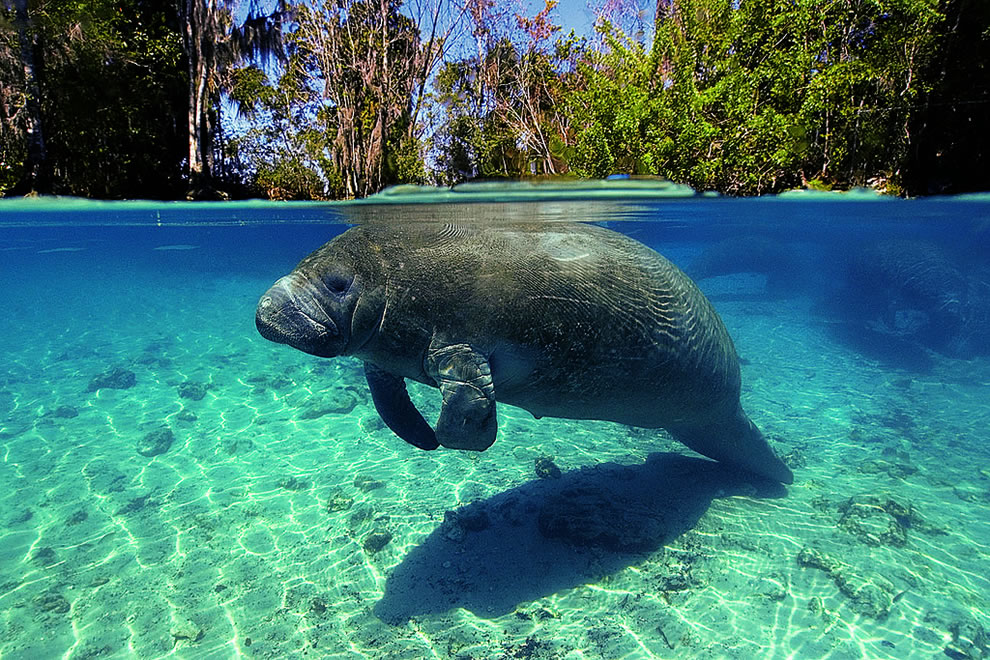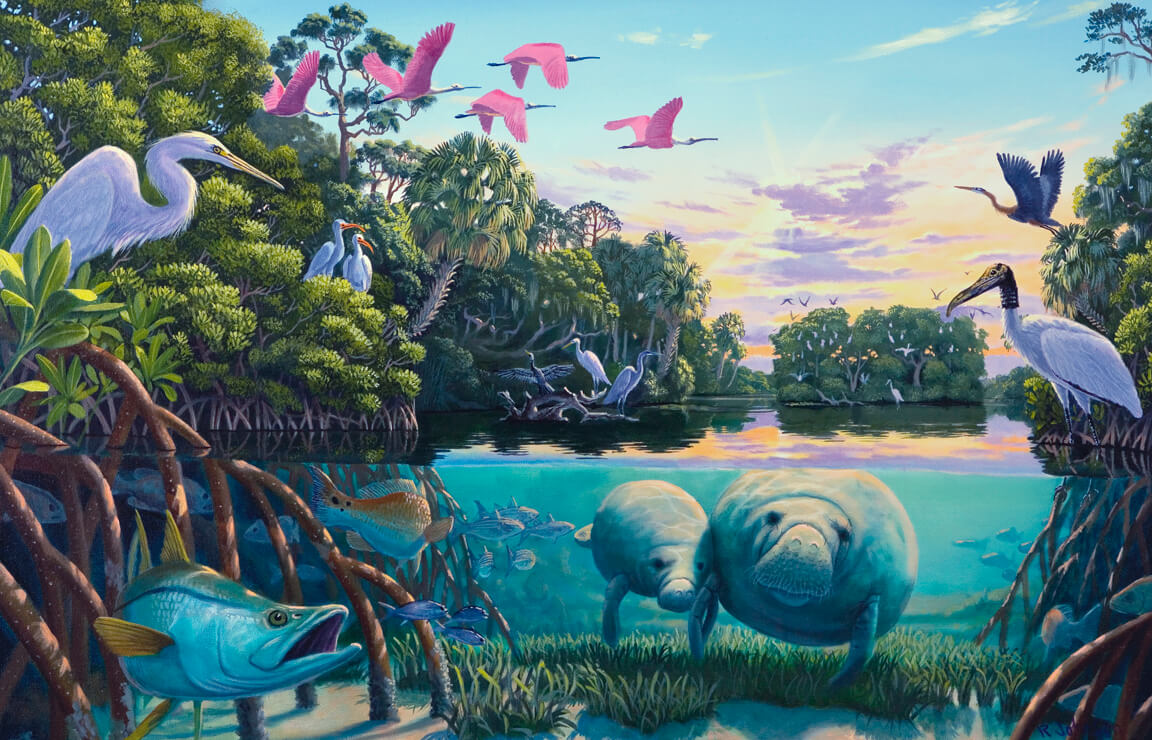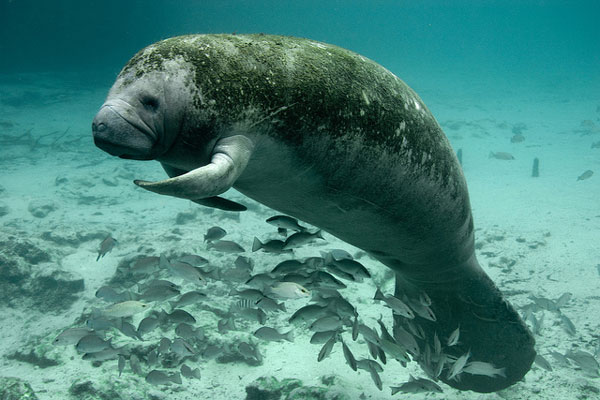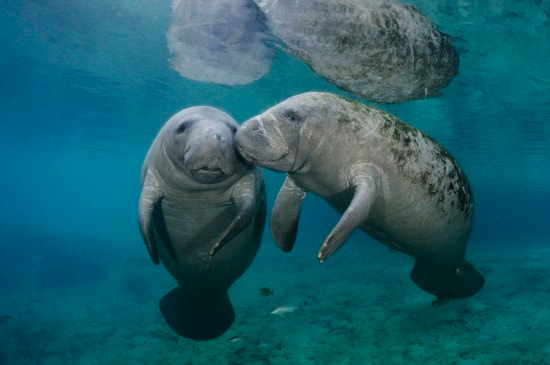|
There are 9 notable differences between a Manatee and a Dugong. Both manatees and dugong's are classified in the order Sirenia. They are both slow-moving herbivores (mostly) that can be found in areas of shallow waters along warm coastlines. There are (4) four living species of Sirenia – (1) the West Indian manatee, (2) the Amazonian manatee, (3) the West African manatee, (4) the dugong and the extinct Stellar’s sea cow (hunted to extinction in the 18th Century). They are all found in different areas, so depending on where you are, you will know what you are looking at! Some people mistakenly think dugongs and manatees are the exact same animal with different names. Though manatees and dugongs have a lot in common, they are different animals with distinct characteristics. Both dugongs and manatees are part of the same taxonomic order, Sirena. The word “siren” means mermaid in many languages, a nod to the animals’ history of being mistaken for mermaids. At one time, there were five different types of sirena, three types of manatees (Amazonian, West African and West Indian), Steller’s sea cow, and the dugong. Sadly, Steller’s sea cow was hunted to extinction in the 1700s. Basic Facts About Manatees - Manatees live in shallow, marshy areas in the Amazon Basin, Caribbean, Gulf of Mexico and West Africa. Unlike dugongs, who live their entire lives in saltwater, manatees can spend some or all of their time in freshwater. Cold water can be stressful for manatees. When water temps drop below 20°C/68°F, manatees travel to warmer water, including natural springs and even power plant outflows. On average, manatees grow to 3.6 meters/11.8 feet long and weigh 200-600 kg/440-1300 lbs. These enormous vegetarians eat plants found in shallow water such as sea-grass, mangroves and sometimes algae. The Florida manatee, a subspecies of the West Indian manatee, is the largest of all sirenas and can grow up to 4 meters/13 feet long and weigh 1590 kg/3500 lbs. DIFFERENCE #1 - Habitat (where you find them)
Habitat - Manatees inhabit the marshy areas of the Caribbean and Gulf of Mexico (West Indian Manatee), the Amazon Basin (Amazonian Manatee) and West Africa (West African Manatee). Dugong's spend their entire life in shallow, protected areas such as bays and mangrove swamps (they can be found in places like Bazaruto / Vilanculos in Mozambique and Marsa Alam in Egypt) as well as the waters off northern Australia. DIFFERENCE #2 - Tail Tails - Manatees have a large, horizontal, paddle-shaped tail with only one lobe, which moves up and down when the animal swims. Dugong's have tail flukes with pointed projections, like a whale with a slightly concave trailing edge. DIFFERENCE #3 - Nails Nails - West Indian and West African manatees have very basic nails on their forelimbs. Amazonian manatees and dugongs don’t have any nails. DIFFERENCE #4 - Nostrils Nostrils - The nostrils of a Dugong are placed further back on its head than in the case of manatees. DIFFERENCE #5 - Mouths Mouths - The angle of the dugong’s mouth is more pronounced than that of the manatee. It has a short, broad, downward facing trunk-like snout that is horseshoe-shaped with a slit-like mouth with an undivided upper lip. Because of this they are bottom-dwelling. Manatees have a divided upper lip and a shorter snout which means they are able to gather food to eat and are also able to feed on plants growing at or near the surface of the water. DIFFERENCE #6 - Teeth Teeth - Mature male dugongs have a pair of tusk-like incisors and manatees do not. Manatees have no incisors, only cheek teeth (molars) which are continuously replaced – its molars move forward in the mouth, stimulated by the chewing motion, towards the front of its jaw until it falls out at the front. As the teeth move forward, they are replaced by new ones at the back – rather like a conveyor belt! They usually have no more than 6 teeth in either jaw at any one time. The two rear molars in dugongs are open rooted which means as they are worn away, they just continue to grow. DIFFERENCE #7 - Social Life Social Life - Manatees are generally solitary creatures and a male manatee may have several female partners; while Dugongs are more solitary and tend to live in pairs and have only one mate. DIFFERENCE #8 - Offspring Dugong with Calf Dugong's Offspring - Female dugong's usually only give birth at 10 years and usually only every 3 – 5 years after that. Because of their long lifespan (70 years) and slow rate of reproduction, and because dugongs continue to be hunted in Africa for their blubber and meat, they are IUCN’s list of being vulnerable to extinction. Manatee with Calf Manatee Offspring - Female manatees usually give birth at 3 years and continue to do so every 2 – 3 years. Their gestation period is 12 months. DIFFERENCE #9 - Weight Weight - Manatees are generally larger than Dugongs and can weigh between 400 and 500 kg and grow to a length of 3.6 meters. Dugongs rarely grow larger than 3 metres and weight is, on average 420 kg. DUGONG MANATEE
0 Comments
 MANATEE IN BELIZE You may not think that the manatee, is something you would encounter on your walk in the jungle, but if your jungle walk follows the sea, then you may very well encounter manatees playing in the rivers and estuaries. The manatee, cruises the coastal waters from Florida to northern Brazil. It moves along at a leisurely pace, browsing for food, walking the bottom on its oar-like flippers while uprooting sea grasses, or galumphing through the shallows searching for floating plant life. Every four or five minutes its snout must emerge to take in a deep breath and at most, it will average six miles per hour, not allowing for resting or for horsing around. The manatee's closest living relative is the elephant. Males are called bulls and the females are called cows. Manatee make random squeaks and chirps white submerged, with no real sense of rhythm. Only between mother and child do their sounds appear to be communicative. Manatee can tip the scales between 400 and 1,300 lbs., all of it pudgy, and they have no neck whatsoever. The tail is fat like a spatula, the muzzle folds over the mouth, and the skin is gray or brown, covered with fine wrinkles and short, upigmented hairs. The manatee have special appeal for us humans. It is gentle and shy, and is near-sighted. It is rarely aggressive - only the bumping of bulls in competition for the attention of a female and often playful, including quite a bit of indiscriminate kissing. When it becomes accustomed to the company of human beings, the manatee will include these creatures in its games. Manatees group and regroup. The only long-term association they make is between cow and calf, which lasts up to two years; the youngster suckles underwater, from teats beneath the mother's flippers. Manatees breed throughout the year. Gestation takes up to 400 days, can you believe it! The average lifespan is not known, although it is recorded that one manatee in captivity lived to the age of twenty-three. Manatees are strict vegetarians, and in return are not a food source for other animals - except man. They have been hunted for their hides, their oil, and their flesh. Here in Belize it is widely and mistakenly held that as meat it has special properties, and that it includes a variety of flavors. Also, the bones are used for jewelry making. However, through the Belize Zoo's nationwide educational campaign, it is hoped that the continued illegal killing of this endangered species will soon cease. An even greater danger to the manatee's survival is involuntary slaughter by the propeller blades of motor boats. Although its hearing is abnormally sensitive, and in an emergency it is able to gear up to 15 m.p.h., still the manatee does not seem to recognize the sound of impeding doom. Other threats to its life are cold snaps, and the careless use of herbicides. And just for the record, the water hyacinth, is the manatee's favorite food!  You may not think that the manatee, is something you would encounter on your walk in the jungle, but if your jungle walk follows the sea, then you may very well encounter manatees playing in the rivers and estuaries. The manatee, cruises the coastal waters from Florida to northern Brazil. It moves along at a leisurely pace, browsing for food, walking the bottom on its oarlike flippers while uprooting sea grasses, or galumphing through the shallows searching for floating plant life. Every four or five minutes its snout must emerge to take in a deep breath and at most, it will average six miles per hour, not allowing for resting or for horsing around. The manatee's closest living relative is the elephant. Males are called bulls and the females are called cows. Manatee make random squeaks and chirps white submerged, with no real sense of rhythm. Only between mother and child do their sounds appear to be communicative. Manatee can tip the scales between 400 and 1,300 lbs., all of it pudgy, and they have no neck whatsoever. The tail is fat like a spatulate, the muzzle folds over the mouth, and the skin is gray or brown, covered with fine wrinkles and short, upigmented hairs. The manatee have special appeal for us humans. It is gentle and shy, and is near-sighted. It is rarely aggressive - only the bumping of bulls in competition for the attention of a female and often playful, including quite a bit of indiscriminate kissing. When it becomes accustomed to the company of human beings, the manatee will include these creatures in its games. Manatees group and regroup. The only long-term association they make is between cow and calf, which lasts up to two years; the younster suckles underwater, from teats beneath the mother's flippers. Manatees breed throughout the year. Gestation takes up to 400 days, can you believe it! The average lifespan is not known, although it is recorded that one manatee in captivity lived to the age of twenty-three. Manatees are strict vegetarians, and in return are not a food source for other animals - except man. They have been hunted for their hides, their oil, and their flesh. Here in Belize it is widely and mistakenly held that as meat it has special properties, and that it includes a variety of flavors. Also, the bones are used for jewelry making. However, through the Belize Zoo's nationwide educational campaign, it is hoped that the continued illegal killing of this endangered species will soon cease. An even greater danger to the manatee's survival is involuntary slaughter by the propeller blades of motor boats. Although its hearing is abnormally sensitive, and in an emergency it is able to gear up to 15 m.p.h., still the manatee does not seem to recognize the sound of impeding doom. Other threats to its life are cold snaps, and the careless use of herbicides. And just for the record, the water hyacinth, is the manatee's favorite food! |
Is located on the island of Ambergris Caye, directly across from the Belize Barrier Reef, off the mainland coast of Belize. The property is nestled in a cluster of Australian Pine trees, backed to a littoral jungle, and surrounded by tropical gardens. It's about a one minute walk from the property to the beach, and a 10-15 minute drive from the island airstrip to the property.
We offer one bedroom suites (455 s.f.) of living area to include: livingroom, kitchenette, private bathroom and bedroom. We are also about a one minute walk from one of the best restaurants on the island serving (breakfast, lunch & dinner). Within walking distance you can find: (3) blocks is Robyn's BBQ (4) blocks is 2 fruit stands (5) blocks local grocery store IF YOU'RE COMING TO BELIZE TO............... If you're coming to Belize to dive the Blue Hole, descend the shelf walls at Turneffe, snorkel the Barrier Reef, explore Mayan ruins, rappel into a cave, kayak along the river through caves, zip line through jungle tree tops, hike through a cave to see an ancient human skeleton, swim with sharks, listen to Howler Monkey's, hold a boa constrictor, feed a jaguar, horseback ride through the jungle, canoe through a cave, rappel down a waterfall, sail around an island, enjoy cocktails & dinner to a sunset, climb 130' feet to the top of a Mayan ruin, rip up the jungle trails on an ATV, float through a series of caves on a tube, and sip on a rum punch..... then this is the place for you. Belize Budget Suites, offers you clean, affordable, attractive, accommodations, at prices that allow you to do all the things just mentioned. Archives
February 2021
Categories
All

For All Your Home Improvement Needs

For all Your Real Estate Needs
501-226-4400 10 Coconut Dr. San Pedro, Belize Your Ad Could Go Here
|





































 RSS Feed
RSS Feed























